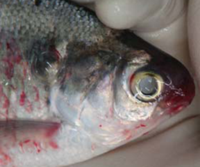
Photo from wikipedia
Haemogregarina species are apicomplexan blood parasites infecting vertebrates such as fish, lizards, and turtles. Due to the high morphological similarity of the erythrocytic stages infecting host species, it has always… Click to show full abstract
Haemogregarina species are apicomplexan blood parasites infecting vertebrates such as fish, lizards, and turtles. Due to the high morphological similarity of the erythrocytic stages infecting host species, it has always been a challenge to identify the true diversity of these parasites. Therefore, taxonomic studies are presently based on the combination of morphological and molecular data. In Tunisia, two species of Haemogregarina have been reported within the freshwater turtle Mauremys leprosa (Geoemydidae) for more than 40 years. Since M. leprosa occurs in the same aquatic environments as Emys orbicularis (Emydidae) in Tunisia, our objectives were to assess parasite diversity and specificity on the basis of both morphological and molecular approaches. The turtles were surveyed and sampled across six aquatic areas of Tunisia. Among the 39 specimens of M. leprosa and seven of E. orbicularis that were trapped and investigated, the presence of haemogregarines was detected in the blood of turtles only at sites where leeches were observed. Three 18S variants were identified, which corresponded to three distinct Haemogregarina species, among which one was identified as Haemogregarina stepanowi. The two other species that were detected are likely new to science. Because we show the occurrence of more than one blood parasite species within a single host specimen, our study provides the first report of coinfection with molecularly distinct Haemogregarina spp.
Journal Title: Parasitology Research
Year Published: 2020
Link to full text (if available)
Share on Social Media: Sign Up to like & get
recommendations!